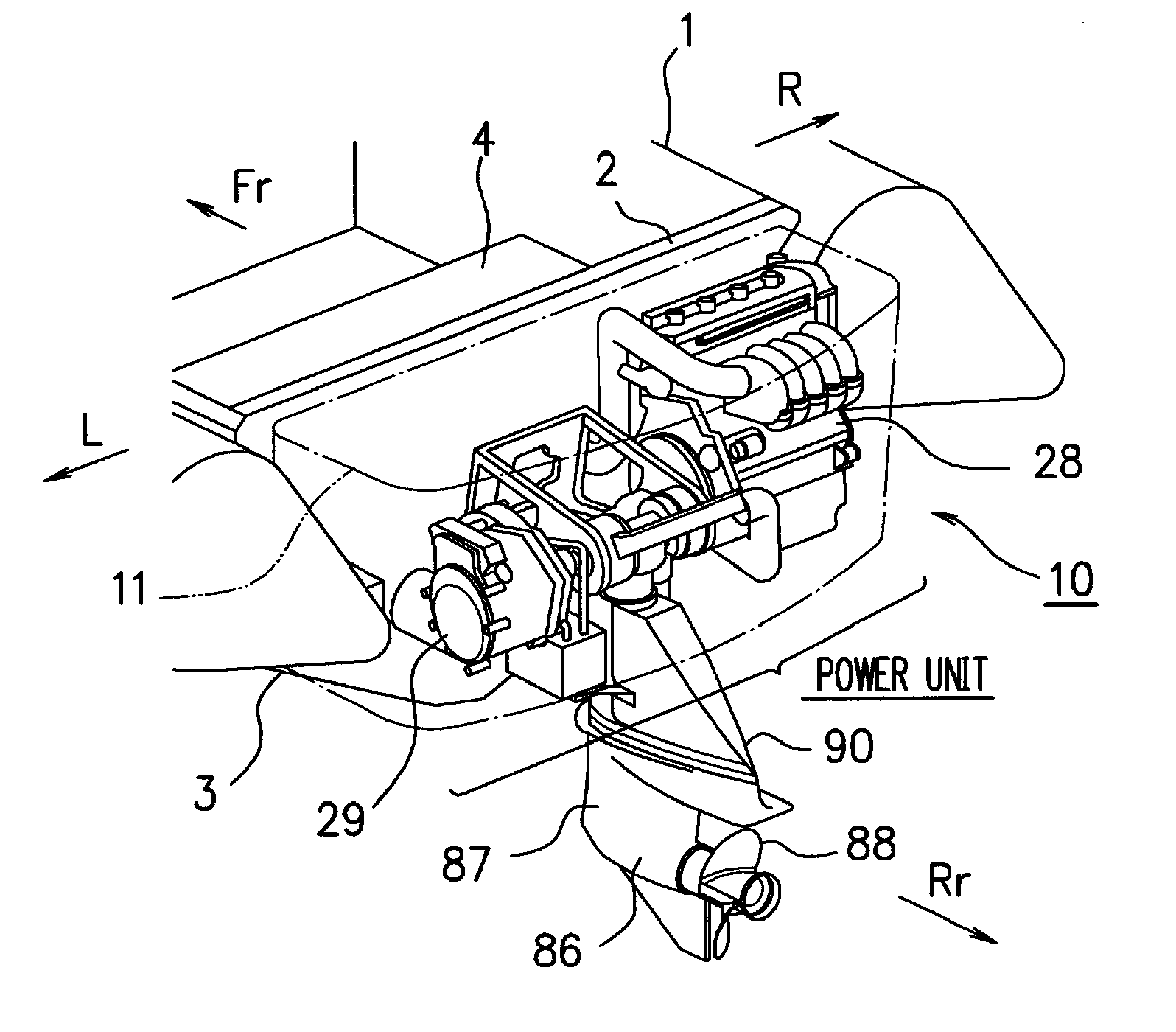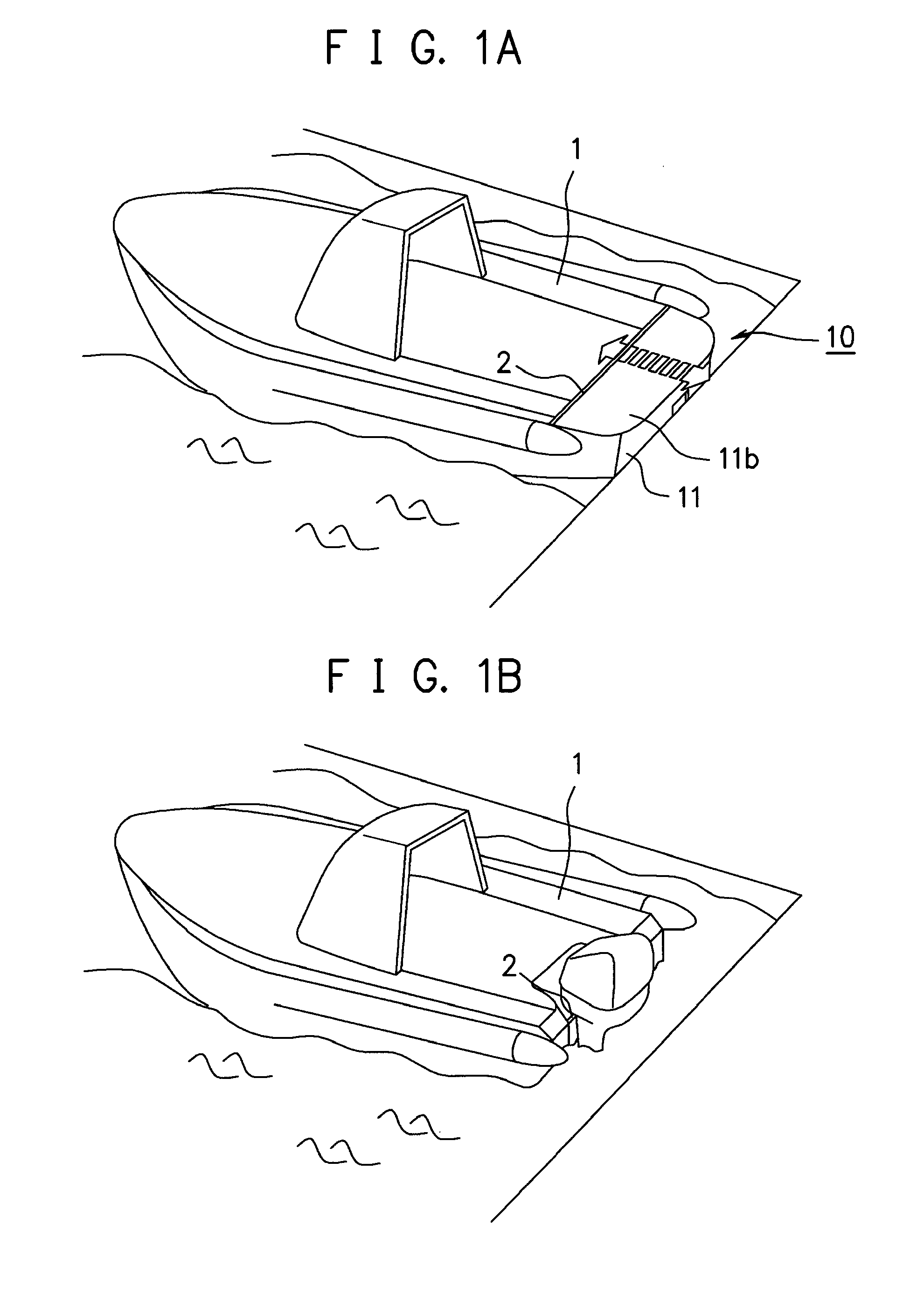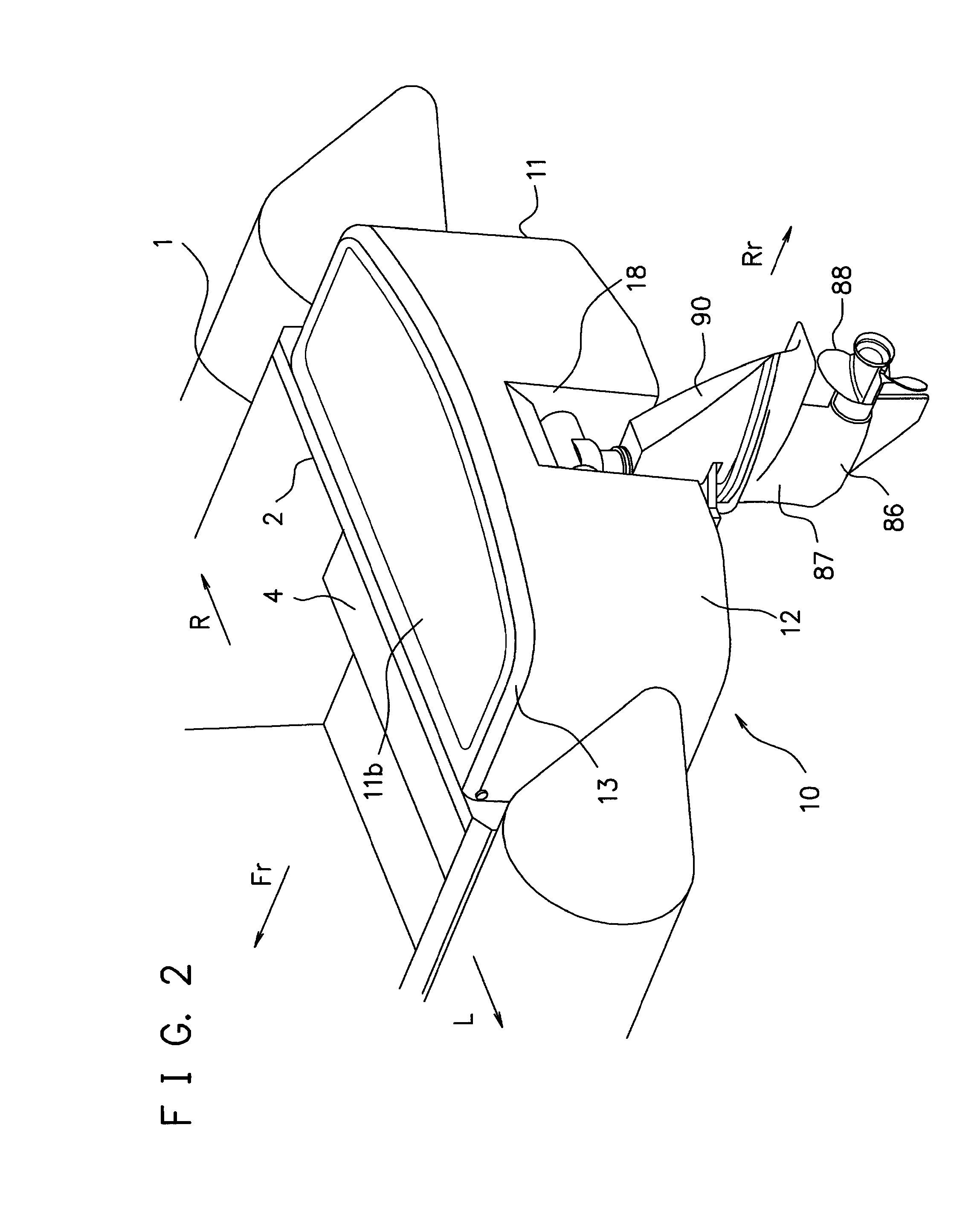Particularly regarding the outboard motor, problems of conventional arts are considered.
First, it is mounted in a form covering the
stern (transom board), and thus the vicinity of the
stern becomes a
dead space, that is, it has a practical problem of not allowing boarding / getting off or the like using this space.
Further, the outboard motor mounted onto the
stern becomes an obstacle.
Thus, a net, a caught fish or the like cannot be taking in via the stern.
Further, it is formed of a body completely separated from the boat
hull, and it is quite difficult to match colors and shapes in the design of the
hull and the design of the outboard motor.
Here, problems in packaging of conventional outboard motors are considered in relation with the inboard motor or the inboard-outdrive motor as other packaging methods.
The inboard motor has a
propeller shaft, a
propeller, a
rudder, and the like projecting from the boat bottom which generate large fluid resistance, resulting in poor cruising performance and
fuel efficiency.
With the inboard motor in which the
propeller shaft, the propeller, the
rudder, and the like project from the boat bottom, it is not possible to
cruise in a
shallow sea area.
When collided against a floating object on the water, the inboard motor can be damaged to a great extent because no shock absorbing mechanism is provided in itself.
Further, since the engine is located inside the
hull or in a deep position in the hull, maintenance is also laborsome.
Thus, the height of the gear case when tilted at a maximum position is low, and it is practically difficult to be pulled up above the water.
Accordingly, when kept on the water, the propulsion unit cannot be in a dry state, and it is difficult to
corrosion resistance.
Thus, the motor has a small
steering angle which results in poor turning performance.
In the inboard-outdrive motor, the engine
drive shaft and the propulsion unit
drive shaft are mechanically coupled, and thus relative positions of them are limited.
Therefore, adjustment to an optimum propelling axis (propeller) position, which is determined by a boat shape, an operating condition, and the like, is not possible.
When a motor is placed right below a
vertical axis engine (in the upward and downward direction) as a characteristic of the outboard motor (parallel
hybrid system), the motor is sandwiched by the engine and an oil pan, and this lowers oil dripping performance of the engine.
Further, the motor obstructs an exhaust passage of the engine, a cooling water passage of the engine, and a lubricating oil passage of the engine, posing difficulties in engine cooling,
lubrication, and exhaust
processing.
Moreover, since the motor is surrounded by the engine, engine exhaust, and heat of the oil pan, it is difficult to cool the motor, and thus performance of the motor cannot be increased.
Unspring weight increases and thus a steering driving force, a shock absorbing device, an engine suspension device, and an engine vibration damping device become large, resulting in increase in all of the size, weight and cost as the whole.
When the engine and the motor are placed in a gear case, in the parallel
hybrid system the gear case becomes large, which increases its fluid resistance and worsens cruising performance and
fuel efficiency.
Unspring weight and the
inertial mass around the tilt axis increase and thus a steering driving force, a shock absorbing device, an engine suspension device, and an engine vibration damping device become large, leading to increase in size, weight, and cost as the whole.
Further, when the engine is placed at a position as is conventional and the motor is placed in the gear case (parallel
hybrid system), the gear case becomes large since the motor is located in the gear case, which increases its fluid resistance and worsens cruising performance and
fuel efficiency.
When a speed
reducer is provided between the motor and the propeller to optimize efficiency of each of them, the gear case further becomes large, which further worsens cruising performance and fuel efficiency.
Further, since there is a
large distance between the motor and the engine, a
delay and / or a mechanical loss occur when restart of the engine is performed by the driving motor accompanying stopping of idling, which is a fuel efficiency improving feature of the hybrid system.
Unspring weight and the
inertial mass around the tilt axis increase and thus a steering driving force, a shock absorbing device, an engine suspension device, and an engine vibration damping device become large, leading to increase in size, weight, and cost as the whole.
Further, the generator obstructs an exhaust passage of the engine, a cooling water passage of the engine, and a lubricating oil passage of the engine, posing difficulties in engine cooling,
lubrication, and exhaust
processing.
Moreover, since the generator is surrounded by the engine, engine exhaust, and heat of the oil pan, it is difficult to cool the generator, and thus performance of the generator cannot be increased.
Since the motor is located in the gear case, the gear case becomes large, which increases its fluid resistance and worsens cruising performance and fuel efficiency.
When a speed
reducer is provided between the motor and the propeller to optimize efficiency of each of them, the gear case further becomes large, which further worsens cruising performance and fuel efficiency.
Unspring weight and the
inertial mass around the tilt axis increase significantly and thus a steering driving force, a shock absorbing device, an engine suspension device, and an engine vibration damping device become large, leading to increase in size, weight, and cost as the whole.
When an
engine generator is placed in a separate location (for example in a hull) to solve this,
energy loss is large when current flows in and out of a battery (or an equivalent
energy storage device), yielding quite low efficiency such that the
total efficiency of generator, battery, and motor=generator efficiency×battery charging efficiency×battery discharging efficiency×
motor efficiency.
Particularly, it has not been easy to transmit
motive power of a power source appropriately and efficiency in a limited space in relation to achieving compactness, high performance, and the like.
Further, it has not been easy to tilt or steer smoothly and effectively in a limited space in relation to achieving compactness, high performance, and the like.
 Login to View More
Login to View More  Login to View More
Login to View More 


